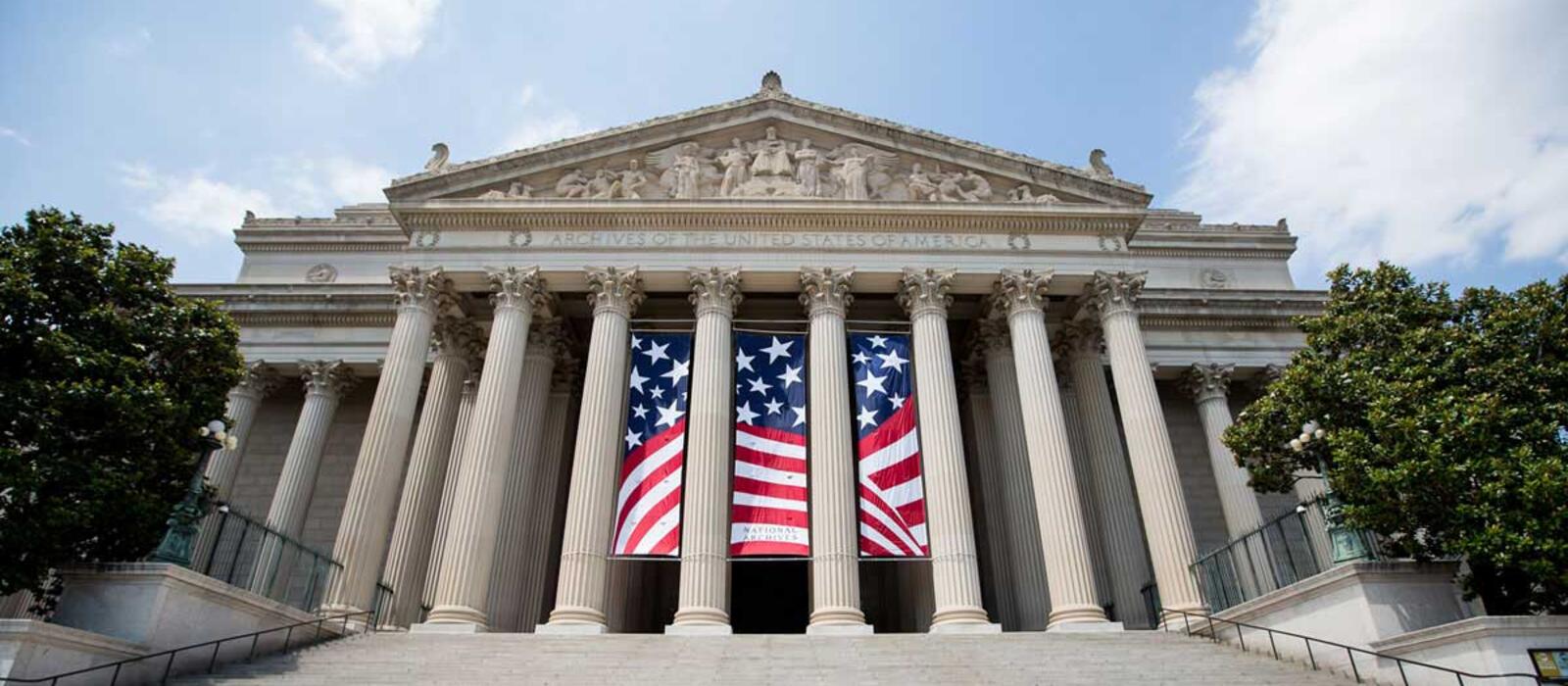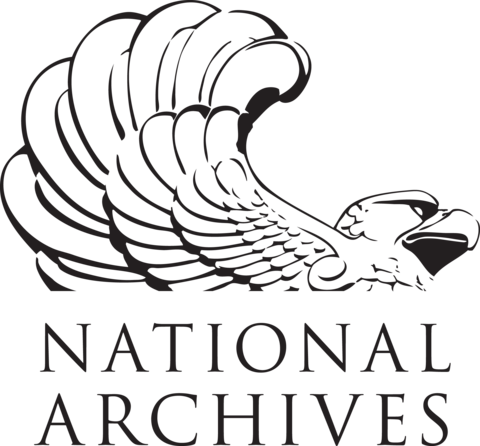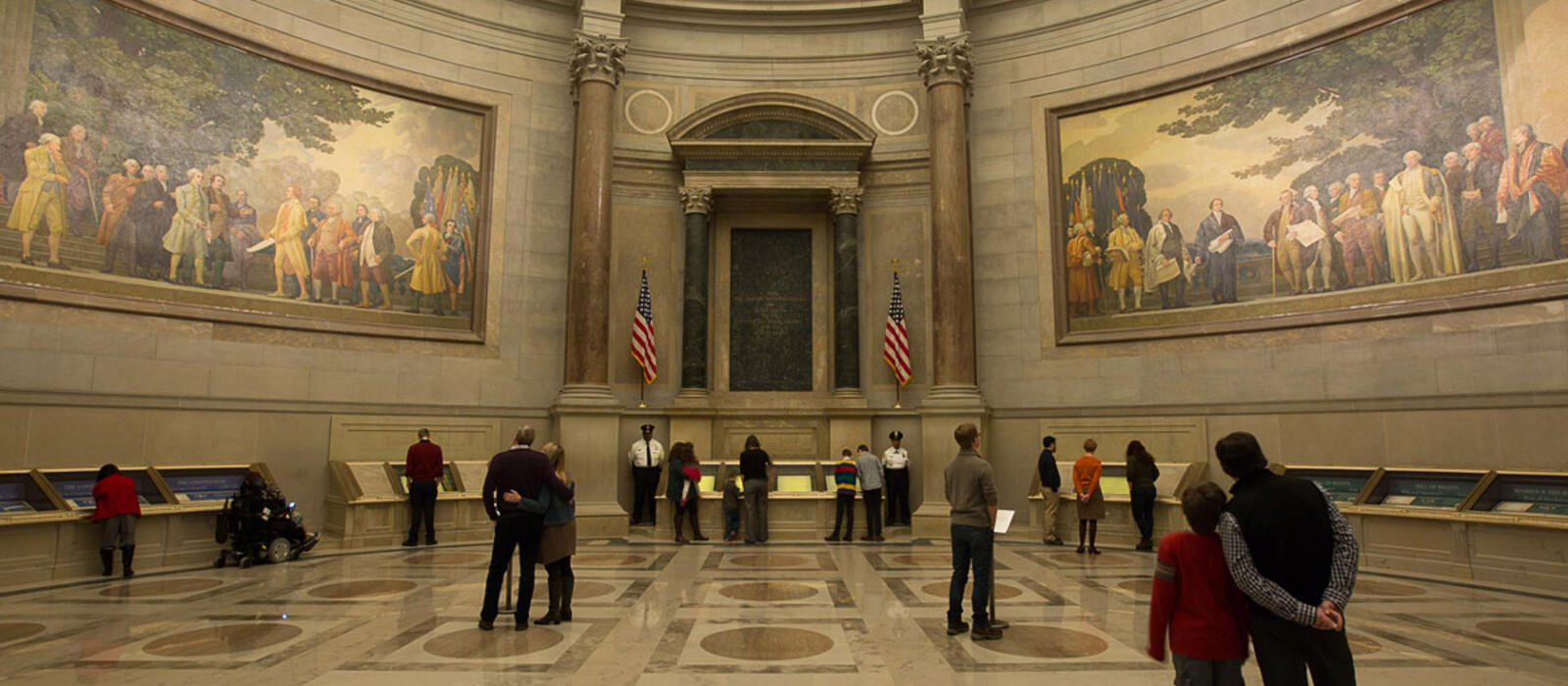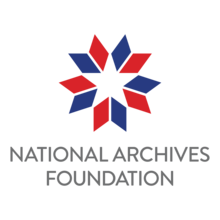

The National Archives and Records Administration is an independent federal agency that preserves and shares with the public records that trace the story of our nation, government, and the American people. From the Declaration of Independence to accounts of ordinary Americans, the holdings of the National Archives directly touch the lives of millions of people. The National Archives carries out its mission through a nationwide network of archives, records centers, and Presidential libraries, and online.
Learn more about the National Archives and Records Administration.
About the National Archives Building in Washington, DC
The National Archives Building, known informally as Archives I, is the headquarters of the National Archives and Records Administration of the United States. The building houses the original copies of the Declaration of Independence, the Constitution, and the Bill of Rights as well as many other important historical documents.
The building was designed in the Classical Revival style by the renowned architect John Russell Pope (1874–1937), whose vision was to create a “temple to history.” Pope, who was strongly influenced by the American Renaissance style and who also designed the Jefferson Memorial and the West Building of the National Gallery of Art, wanted the architecture of the National Archives to reflect the significance, security, and permanence of the records held therein.
Ground was broken on the building site in 1931, and construction began in earnest two years later, with President Herbert Hoover laying the cornerstone in 1933. The building’s ornate exterior took four years to complete. The still incomplete building was opened to staff members in 1935, with construction completed in 1937. The Declaration of Independence, the Constitution, and the Bill of Rights were placed on display in the Rotunda in 1952.
By the 1960s, the National Archives Building had reached its storage capacity of 900,000 cubic feet (25,000 cubic meters), requiring rental of additional space. A second National Archives building in College Park, Maryland, was opened in 1993, giving the National Archives an additional 1.8 million square feet (170,000 square meters) of space for its ever-expanding collection. Public display space was expanded from 12,000 to over 19,000 square feet in 2013.
The National Archives Building was added to the National Register of Historic Places in 1971, and is a contributing property to the Pennsylvania Avenue National Historic Site. In 2023, it was designated a National Historic Landmark.

About the Rotunda
On December 15, 1952, President Harry S. Truman presided over the unveiling of the Declaration of Independence, the Constitution of the United States, and the Bill of Rights in the Rotunda of the National Archives. For more than 70 years, visitors have come to view the original signed documents that are collectively known as the Charters of Freedom.
The majestic domed ceiling of the Rotunda, rising 70 feet above the floor, and the 40-foot-tall bronze doors contribute to the feelings of awe and reverence experienced by visitors to this magnificent space. The curved walls of the Rotunda feature the famous Faulkner Murals, painted by Barry Faulkner in 1935–36, which depict fictional scenes of the presentation of the Declaration of Independence and the Constitution. These paintings are among the largest single-piece oil-on-canvas murals in the United States.
The Declaration of Independence, the Constitution, and the Bill of Rights have been displayed to the public in the Rotunda of the National Archives Building since 1952. Since then, these documents have been routinely inspected by conservators for any sign of deterioration. The documents were taken off display in the Rotunda in 2001 for analysis, enhanced conservation, and re-encasement, and were returned to public display in a special ceremony on September 17, 2003, the 216th anniversary of the adoption of the Constitution.
Frequently Asked Questions About the Rotunda
For 35 years, the Declaration was exposed to direct sunlight opposite a window in the Patent Office Building, which resulted in considerable fading. Today, it is sealed in the most scientifically advanced housing that preservation technology can provide.
Cooler temperatures prolong the life of the historic documents. Light fades ink and destroys parchment and paper, so light levels in the Rotunda are deliberately kept low.
The Declaration of Independence, Constitution, Bill of Rights, and other original documents displayed in the National Archives Rotunda are fragile and at risk of fading from light, especially flash photography. We do, however, encourage non-flash photography in all public areas unless otherwise posted.
The Declaration of Independence, the Constitution, and the Bill of Rights are displayed in hermetically sealed cases. These airtight cases are filled with inert argon gas, which protects the documents. Conservators routinely inspect the encased documents, with the help of an electronic imaging monitoring system developed for NASA by the Jet Propulsion Laboratory.
The Faulkner Murals are a series of oil-on-canvas paintings that were painted in 1935 and 1936 by artist Barry Faulkner. They depict the writing and adoption of the Declaration of Independence. Faulkner created allegorical (symbolic or metaphorical) scenes depicting the writing and adoption of the Declaration of Independence and the Constitution of the United States. These massive murals, each about the size of a city bus (14 feet by 37.5 feet), add life and color to the space.

About the National Archives Foundation
The National Archives Foundation is an independent nonprofit that increases public awareness of the National Archives, inspires a deeper appreciation of our country’s heritage, and encourages citizen engagement in our democracy. As the National Archives’ nonprofit partner, the Foundation generates financial and creative support for National Archives exhibitions, public programs, and educational initiatives, introducing America’s records to people around the U.S. and the world. The Foundation’s support makes possible the National Archives exhibits in Washington, DC.